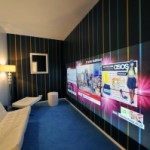Want to reinvent TV? Don’t forget the TV
...[NDS] The Israel-based TV services provider, which Cisco acquired for $5 billion in March, has been exploring what the actual TV set will look like five years from now. Company executives came to San Francisco this week to showcase some of their research, and the results are pretty intriguing.
To sum it up briefly, NDS was showcasing a big matrix of six bezel-less flat screen TVs that were combined to form a huge, almost overwhelming TV wall. NDS CTO Nick Thexton then went on to demonstrate big displays like these can be broken up, showing a video of varying sizes somewhere in the middle, with personalized and content-relevant widgets off to the side. And once you get some cinematic 4k content, you might even want to use the whole screen. Check out Christina Bonnington’s story over at Wired.com for more details about the demo, which was neat.
But what I found fascinating was the points that Thexton and NDS Chief Marketing Officer Nigel Smith raised about the future of TV. The real question, Smith told me, is, If you have a TV the size of a wall, how are you going to interact with it? ...
Instead, Thexton thinks that TVs may become modular and actually consist of much smaller displays that can be combined to fit the room. Think of 6-inch to 8-inch bezel-less squares that you can buy individually and then mount to the wall next to one another, gradually growing the size of your display to fit your needs. These displays would automatically work together, making sure your Saturday night movie runs on all of them at once. ...
One of the main points of the NDS demo was that huge displays don’t always equal huge videos. Instead of watching your morning news in theater mode, you’re going to watch clips with a much smaller size and use the rest of the screen for other information. In fact, sometimes you might not be watching TV at all but will still find it useful to leave the large screen wall on. For example, it could display cover art for the music you are listening to while giving you access to your calendar reminders, a wall-sized clock and your Twitter feed. Home automation and security-camera footage are also applications that could be useful to run all day, or fade in and out as needed.
But with that big ambient screen also comes a unique new challenge: You really don’t want to turn it off. ...
NDS ran its demo off an iPad, allowing me to change the immersion level — and display size — of a video with simple sliders. ...
A TV that consists of many little displays working together, a TV that’s always on, a TV the size of your living room wall and a TV that obeys you like a well-trained dog: That’s a lot to swallow, especially if you’ve thought of the next wave of apps as innovation in the TV space.
However, it may be time to think bigger, and leave some of the assumptions of what TV is — and what TV sets are — behind. “TV has to start defining a future for itself,” Thexton told me. And that future may not fit into a 60- or 70-inch bezel.
See the full story here:
Pages
- About Philip Lelyveld
- Mark and Addie Lelyveld Biographies
- Presentations and articles
- Tufts Alumni Bio
